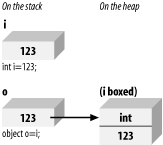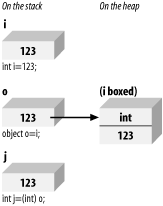5.6 Boxing and Unboxing Types
| Boxing and unboxing are the processes that enable value types (e.g., integers) to be treated as reference types (objects). The value is "boxed" inside an Object, and subsequently "unboxed" back to a value type. It is this process that allows us to call the ToString( ) method on the integer in Example 5-4.
5.6.1 Boxing Is ImplicitBoxing is an implicit conversion of a value type to the type Object. Boxing a value allocates an instance of Object and copies the value into the new object instance, as shown in Figure 5-4. Figure 5-4. Boxing reference types Boxing is implicit when you provide a value type where a reference is expected. For example, if you assign a primitive type, such as an integer to a variable of type Object (which is legal because int derives from Object), the value is boxed, as shown here: using System; class Boxing { public static void Main( ) { int i = 123; Console.WriteLine("The object value = {0}", i); } } Console.WriteLine( ) expects an object, not an integer. To accommodate the method, the integer type is automatically boxed by the CLR, and ToString( ) is called on the resulting object. This feature allows you to create methods that take an object as a parameter; no matter what is passed in (reference or value type), the method will work. 5.6.2 Unboxing Must Be ExplicitTo return the boxed object back to a value type, you must explicitly unbox it. You should accomplish this in two steps:
Figure 5-5 illustrates. Figure 5-5. Boxing and then unboxing For the unboxing to succeed, the object being unboxed must be a reference to an object that was created by boxing a value of the given type. Boxing and unboxing are illustrated in Example 5-5. Example 5-5. Boxing and unboxingusing System; public class UnboxingTest { public static void Main( ) { int i = 123; //Boxing object o = i; // unboxing (must be explict) int j = (int) o; Console.WriteLine("j: {0}", j); } } Example 5-5 creates an integer i and implicitly boxes it when it is assigned to the object o. The value is then explicitly unboxed and assigned to a new int whose value is displayed. Typically, you will wrap an unbox operation in a try block, as explained in Chapter 11. If the object being unboxed is null or a reference to an object of a different type, an InvalidCastException is thrown. |
EAN: 2147483647
Pages: 182
